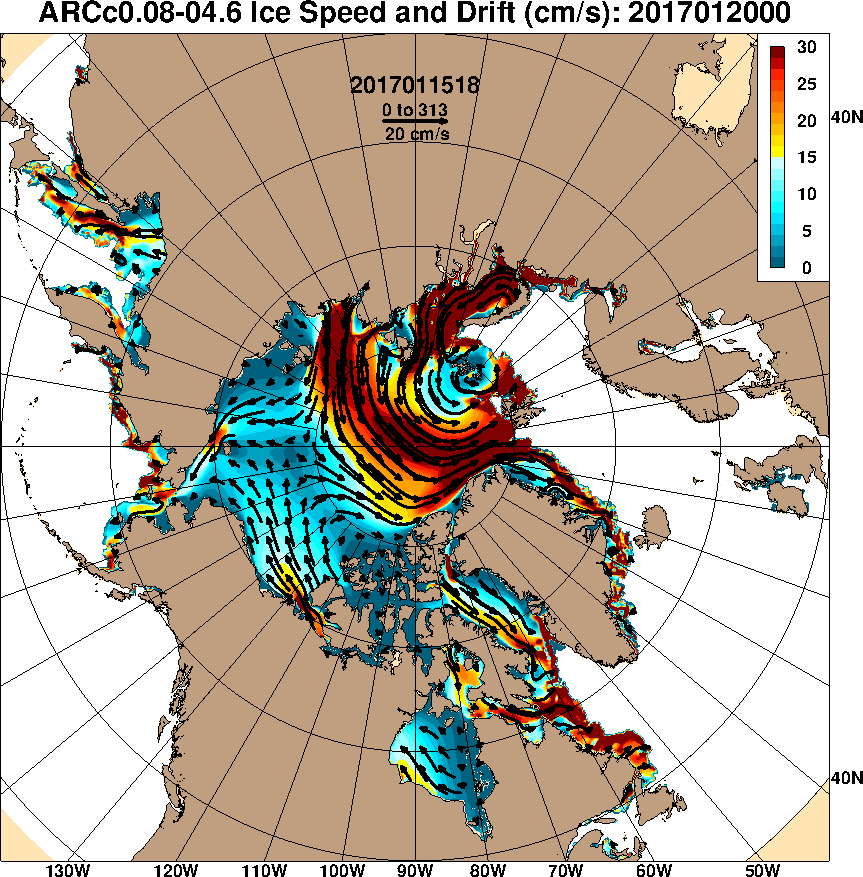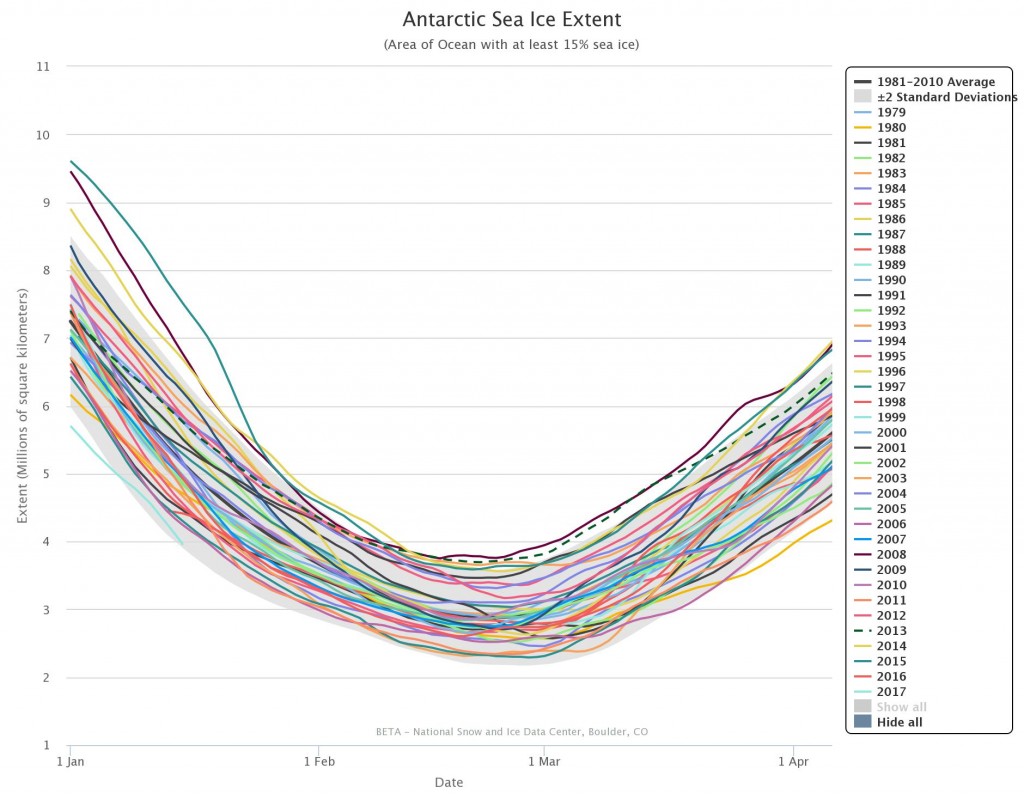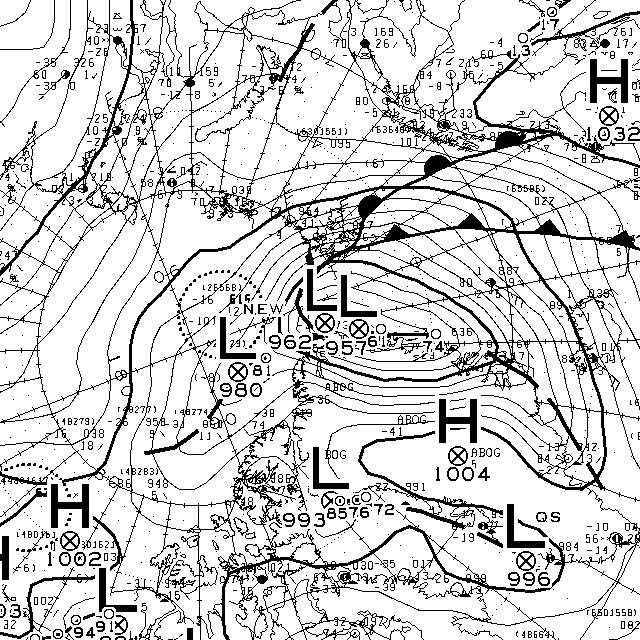Here once again is the up to date version of Wipneus’ graphic graphic, this time of global sea ice extent:
As you can see, global sea ice extent has just reached the lowest ever level in the National Snow and Ice Data Center’s satellite records going back to 1979. It was over a month later when the previous record was broken in February 2016, so there is plenty of time for the metric to fall further.
The 2017 curves in the NSIDC’s own extent graphs are coloured in a pale shade of blue. Even so they’re easy to pick out since both Antarctic and Arctic extent are at the lowest level for the date in NSIDC’s records by a considerable margin:
Antarctic sea ice extent is still falling, and the Arctic has been flatlining for several days now and more trouble is heading its way. Another Fram Strait cyclone is brewing, and this time around the storm’s minimum central pressure is already down to 957 hPa according to Environment Canada:
According to the current forecasts it will continue to spin over the central Arctic for several more days, driving export of sea ice via the Fram Strait:

* In NSIDC satellite records going back to 1979




Following the recent storm Arctic sea ice extent is now back in amongst the pack of previous years:
On the Atlantic side of the Arctic after an initial reduction the anticipated increase in extent due to Fram Strait export has begun:
Sea ice has reached the north coast of Svalbard once again:
Meanwhile over on the Pacific periphery there has been a marked increase in extent in the Bering Sea and the Sea of Okhotsk:
It’s all seeming to normalise a bit now, strictly speaking about the numbers.
I think the next indicator that needs to be nailed to the wall by the internet at large regards the moulins in Greenland. The volume numbers, being so difficult to come across, need highlighting in the anticipatory sense and area and extent don’t seem to be doing that.
I think the question now turns to how to put meaningful data and trends together- if there are any to speak of- of the moulins in Greenland.
Put it this way: I would love to see if there are any trends in a time series of moulins in Greenland. This would draw a link if there were infact one to be drawn.
Yet another cyclone is now spinning over the Central Arctic:
This one is down to 953 hPa central presure. Hence the forecast is for continuing export via the Fram and Bering Straits:
Whilst Antarctic sea ice extent is still reducing it looks like global area may well have already reached this year’s minimum value:
I still don’t get it. Why the fuss about preserving ice? Ice kills; warmth promotes life. As we saw in 1816, even a 1C of cooling killed thousands, turned thousands more into climate refugees and gave us a “year without a summer.”
We live in an Ice Age, which is not the normal state of our planet. Life needs warmth. Life needs rain. And global cooling curtail both of these.
Climate has always changed and always will. Given a choice, Global Warming is the far better option. With Global Cooling, we have Ice Age glacial conditions threatening civilization, likely plummeting the population to the tens of thousands, decimating infrastructure, and giving us 90,000 years without summers, rain, crops, food and civilization. With Global Warming, people have to move from the coasts, or have to build dikes.
So, we have a question to answer: Which is more important — coastal real estate and deadly polar ice, or life itself?
Hi Rod,
For more on the “Year without a summer” see:
https://greatWhiteCon.info/2016/04/the-northwest-passage-in-2016/#comment-214196
It seems we’re agreed that the Globe is warming which will inevitably lead to significant sea level rise?
Have you by any chance polled the inhabitants of places like Mumbai, Shanghai, London and New York regarding your suggestion that they “move from the coast or build dikes”?
http://ngm.nationalgeographic.com/2015/02/climate-change-economics/coastal-cities-map
Hi Rod! I won’t be the one to tell you why we need ice (and a lot of it). Even at your age, you’re gonna discover pretty soon for yourself how an arctic with less/no ice does really effect your life.
Just a correction, though.
We do not live in an Ice Age. We live in a relative stable warmer “between”. To be more precise, we lucked up to live in a long “between”, the age called Olocene, lasted about 11,500 years, so far. It is this relative stabilization in the climate that allowed civilization. Stability, and not warmth, is the point. Life (and humans) were there before, in warmer or cooler climates, but we call that Prehistory. For a reason.
Your body has a stable temperature. If it soars, you call it fever. If it soars too much, it’s called death. Same with the planet, Sir.
Tell me how it goes, next time you have a fever and you don’t have ice cubes.
Apologize: Holocene, in English.
Just a correction to myself. I do speak and write in three different languages, but my mother-tongue gets in the way at times.
Sadly, I found out this today:
https://sites.google.com/site/arctischepinguin/home/global-sea-ice
Are we plummeting off the chart?
It certainly looks like the axis on Wipneus’ extent graph will need moving soon:
Global sea ice area still hasn’t made a new low for the year, but it now looks like my earlier “may have” will turn into a “hasn’t yet”!
Miki,
Strictly speaking, we are in an Ice Age – usually referred to as either the Pleistocene Glaciation or the Quaternary Glaciation. The existence of “permanent” ice sheets in both hemispheres is often regarded as the indication of an ice age.
The Holocene epoch is merely the latest in a series of interglacials during which the ice sheets do recede considerably. As you correctly point out, it was during this longer-than-normal time of relatively stable and equable conditions that Homo sapiens made the great leap from being a hunter-gatherer species to an agrarian one. Civilisation – as we know it – is a direct consequence.
OMG. Rod, Rod, Rod. How can you possibly know which is preferable – a new ice age or an unknown planetary fever? What powers persuade you that a hot planet is a healthy planet? Homo sapiens has thrived on the relatively constant climate of the Holocene of the last 10,000 years – just like your body thrives on the relatively constant temperature of 37 deg C, 2 deg C warmth does not “promote life”; increase your temperature to 39 deg C for any length of time and you’ll die. . You can make no assumptions at all on the health of the planet or the species that inhabit it when it is 2 deg C or more warmer. Yes, the planet will survive as it always has, manifestly and seriously changed, and mankind will survive in some attenuated and impoverished fashion, but tell me, when all your coastal land and cities have gone, when all the glaciers and the waters of mountain rivers have gone, when all our forests have been destroyed or burned, when southern Europe, the Middle East, much of Africa, India, China, Australia and the USA becomes deserts, how comfortable will our existence be? I wonder where you live now? Will your abode still be the comfortable or survivable place you now enjoy? The answer to these rhetorical questions is likely no. Only a fool would suggest otherwise. Only a fool would suggest global warming, entirely manmade, is preferable to the status quo. Only a fool would make such a truly absurd posting as yours. I shouldn’t call you names, but honestly, your thought processes are truly infantile. It’s as if what used to be called “common sense” has abandoned our species, now it’s non-news, scientific denial, mendacity, dogma driven argument and contention replacing reason and debate – your posting exemplifies so much of this. Perhaps you live in the USA? Your society has now taken leave of its senses and voted in a President who has honed to perfection all these damaging attributes – I imagine you must think he’s the “Best and Most Beautiful President in History” Fortunately sanity still resides in pockets of intellectual resistance in such places as this forum, but will it be enough? Global warming and intellectual decay are going hand in hand to a frightening future.
I find myself in discussion with the Capital Weather Gang about Arctic sea ice. In amongst the “climate change models” nonsense there has been mention of “bad satellite data” and “the extreme cold in the Antarctic”. It seems to be impossible to embed images over there, so for the benefit of “eric654”, “flyoverplains” et al. here’s the NSIDC’s current interpretation of the SSMIS data from DMSP F18 for the Arctic:
and the Antarctic:
You will no doubt note that both are currently at the lowest level for January 31st in the NSIDC’s records going back to 1979.
Thanks for engaging with those guys, Jim.
I wonder what the import is of the concurrent lows. The two poles normally have uncorrelated ice conditions iirc – did that suddenly change? Guess we won’t know for at least a few more years.
“what is the import of concurrent lows?”
I’ll hazard a guess, in the form of a thought experiment. First the thought experiment from the cooling side: suppose the world is in a long cooling trend, but each year, there is enough heat to melt any ice that formed in protected areas inside the Arctic Circle. It really needed one more push to become a perennially ice-covered area. And then there was a huge volcanic eruption — voila, you have a couple “years without a summer”, and the transition to an ice-covered Arctic is achieved. Years, I might add, in which there are concurrent highs in the amount of polar ice — a step change down in albedo.
Now, how about the thought experiment on the hot side. It isn’t clear to me what the temperature raising analog of a volcano is. Maybe back-to-back El Ninos, maybe something else. But one of the observable manifestations would be concurrent lows in global ice cover — a step change up in albedo.
We may be watching something that has never happened during the existence of the human species, but we do have mathematical bifurcation theory to help us explain.
Jim,
Using the NSIDC monthly figures, global sea ice rolling average annual extent went into record low territory with the publication of the October figures, and was taken lower still with each of the November and December figures.
Their rolling annual average for global sea ice area went into record territory one month earlier, and was lowered further in October, November and December.
No prizes for guessing what the January 2017 numbers will do to both area and extent. (February isn’t looking too clever at the moment either.)
Edit to add: I got my up and down reversed in my previous post. Albedo is Latin for “whiteness”, so more ice>>whiter>> higher albedo. My bad.
Miki – I replied to you further up the page, but it somehow appeared as a reply to Jim.